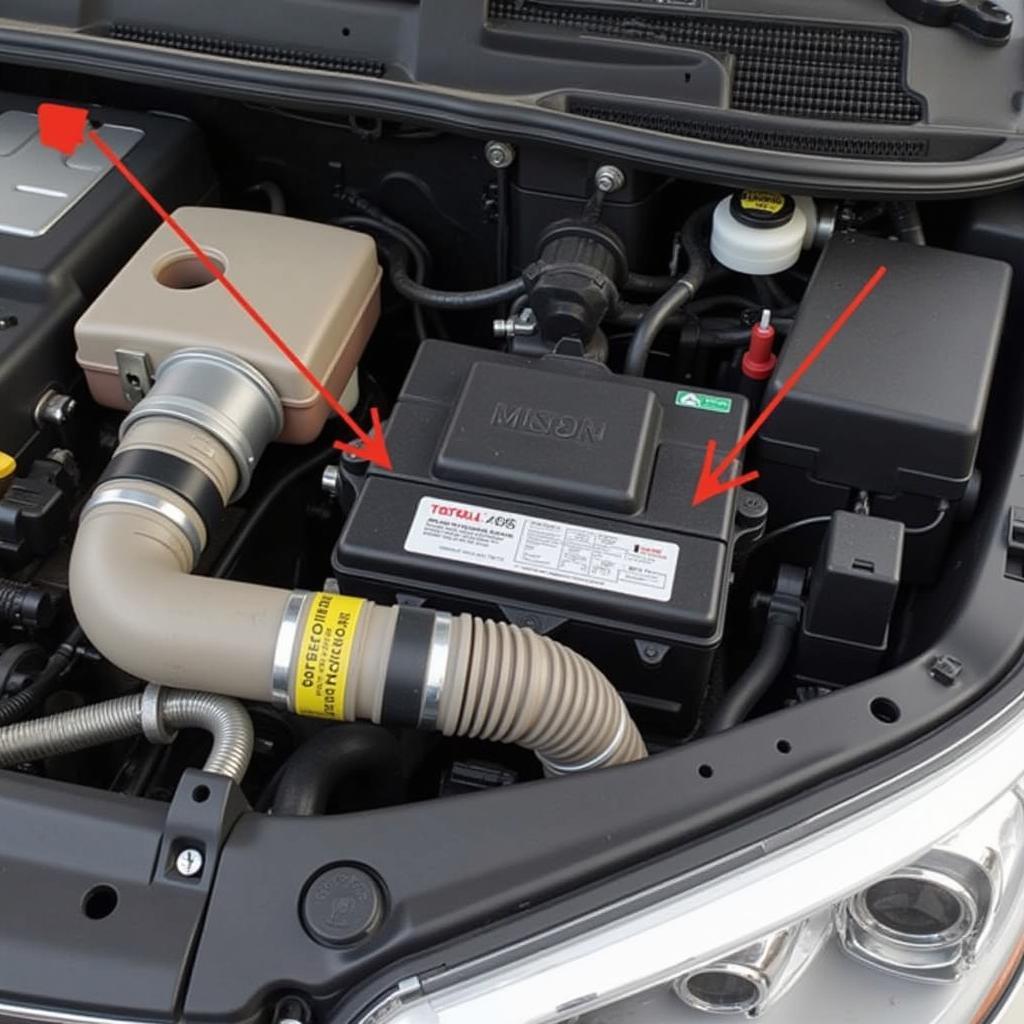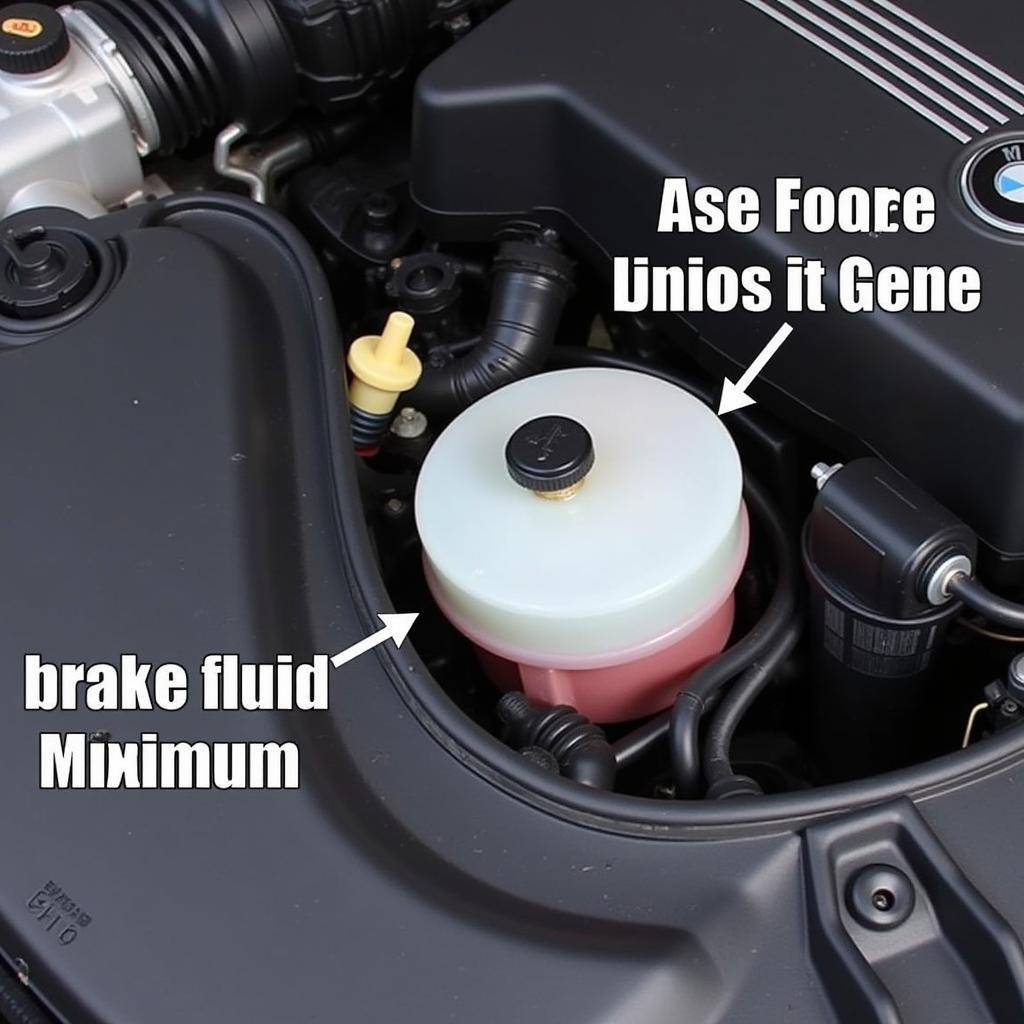A brake reservoir warning light appearing on your dashboard can be a cause for concern. This light typically indicates a problem with your vehicle’s braking system, often related to low brake fluid levels. This article explores the common causes of a brake reservoir warning, potential solutions, and essential safety precautions.
Understanding Your Brake System and the Reservoir Warning Light
Your car’s braking system relies on hydraulic pressure to function correctly. When you press the brake pedal, brake fluid amplifies the force applied, pushing the brake pads against the rotors to slow down or stop your vehicle.
The brake reservoir, a small, translucent container usually located near the firewall on the driver’s side, stores the brake fluid. A sensor inside the reservoir monitors the fluid level. If it detects a drop below a safe level, the brake reservoir warning light illuminates on your dashboard.
Common Causes of a Brake Reservoir Warning Light
While a low brake fluid level is the most common cause, several other factors can trigger this warning light:
- Worn Brake Pads: As brake pads wear down, the brake calipers need to extend further to engage the rotors. This requires more brake fluid, leading to a lower level in the reservoir.
- Brake Fluid Leak: A leak in the brake lines, hoses, calipers, or wheel cylinders can cause a significant drop in brake fluid level, triggering the warning light.
- Faulty Brake Reservoir Sensor: A malfunctioning sensor might provide inaccurate readings, illuminating the warning light even when the fluid level is adequate.
- Air in the Brake Lines: Air trapped in the brake lines can compress, reducing hydraulic pressure and potentially causing a soft or spongy brake pedal. While not directly causing a low fluid level, it can affect braking performance.
What to do When the Brake Reservoir Warning Light Turns On
If the brake reservoir warning light comes on, it’s crucial not to ignore it. Here are the immediate steps you should take:
- Safely Park Your Vehicle: Find a safe location to pull over as soon as possible. Driving with low brake fluid or a compromised braking system is extremely dangerous.
- Check the Brake Fluid Level: With the engine off, carefully open the hood and locate the brake reservoir. Most reservoirs are translucent, allowing you to visually inspect the fluid level. Ensure the fluid level is between the minimum and maximum marks.
- Add Brake Fluid (If Necessary): If the fluid level is low, and you have the correct type of brake fluid on hand, carefully add fluid to the reservoir, bringing it up to the maximum mark.
- Inspect for Leaks: Look for any signs of brake fluid leaks around the reservoir, brake lines, hoses, and near the wheels. Leaks often appear as wet spots or drips of reddish-brown fluid.
- Seek Professional Help: If you notice a leak, the fluid level is critically low, or you’re uncomfortable performing these checks yourself, contact a qualified mechanic immediately.
 Mechanic Checking Brake Fluid Level
Mechanic Checking Brake Fluid Level
Risks of Driving with a Brake Reservoir Warning Light
Driving with a brake reservoir warning light on can have severe consequences:
- Complete Brake Failure: If the brake fluid level drops too low, you may experience complete brake failure, making it impossible to stop your vehicle.
- Reduced Braking Performance: Driving with low brake fluid compromises braking efficiency, leading to longer stopping distances and an increased risk of accidents.
- Damage to Brake System Components: Driving with low brake fluid can damage sensitive brake system components like calipers, cylinders, and ABS modules, leading to costly repairs.
Remote Diagnostic and Programming Services: A Modern Solution for Brake Issues
In today’s technologically advanced world, remote diagnostic and programming services offer a convenient and efficient solution for addressing brake system problems.
How Remote Diagnostics Work:
- Vehicle Connection: Your car is connected to a diagnostic tool that communicates with the vehicle’s onboard computer system.
- Data Transmission: The tool extracts diagnostic data, including fault codes, sensor readings, and system performance information.
- Remote Analysis: This data is transmitted securely to a remote diagnostic technician who analyzes the information to pinpoint the root cause of the problem.
- Solutions and Recommendations: The technician provides a detailed report outlining the issue, potential solutions, and repair recommendations.
Benefits of Remote Diagnostics:
- Convenience: Get your car diagnosed from the comfort of your home or office.
- Faster Diagnosis: Experienced technicians can quickly analyze data and identify issues, often faster than traditional methods.
- Cost-Effective: Remote diagnostics can save time and money by avoiding unnecessary trips to the mechanic.
- Proactive Maintenance: Regular remote diagnostics can help identify potential issues before they escalate into major problems.
Preventing Future Brake Reservoir Warnings
Taking proactive measures can help prevent future brake reservoir warning lights:
- Regular Brake Inspections: Get your brakes inspected at least once a year or every 12,000 miles by a qualified mechanic.
- Brake Fluid Flush: Brake fluid absorbs moisture over time, reducing its effectiveness. Have your brake fluid flushed and replaced every 2-3 years or as recommended by your vehicle manufacturer.
- Pay Attention to Warning Signs: Be aware of any changes in braking performance, such as a soft or spongy brake pedal, unusual noises when braking, or the vehicle pulling to one side when braking.
Conclusion
A brake reservoir warning light should never be ignored. Promptly addressing the underlying issue ensures your safety and prevents further damage to your vehicle’s braking system. While checking the brake fluid level and adding fluid may be a temporary solution, seeking professional help is crucial for a thorough diagnosis and repair. Remember, maintaining a properly functioning brake system is paramount for your safety and the safety of others on the road.


